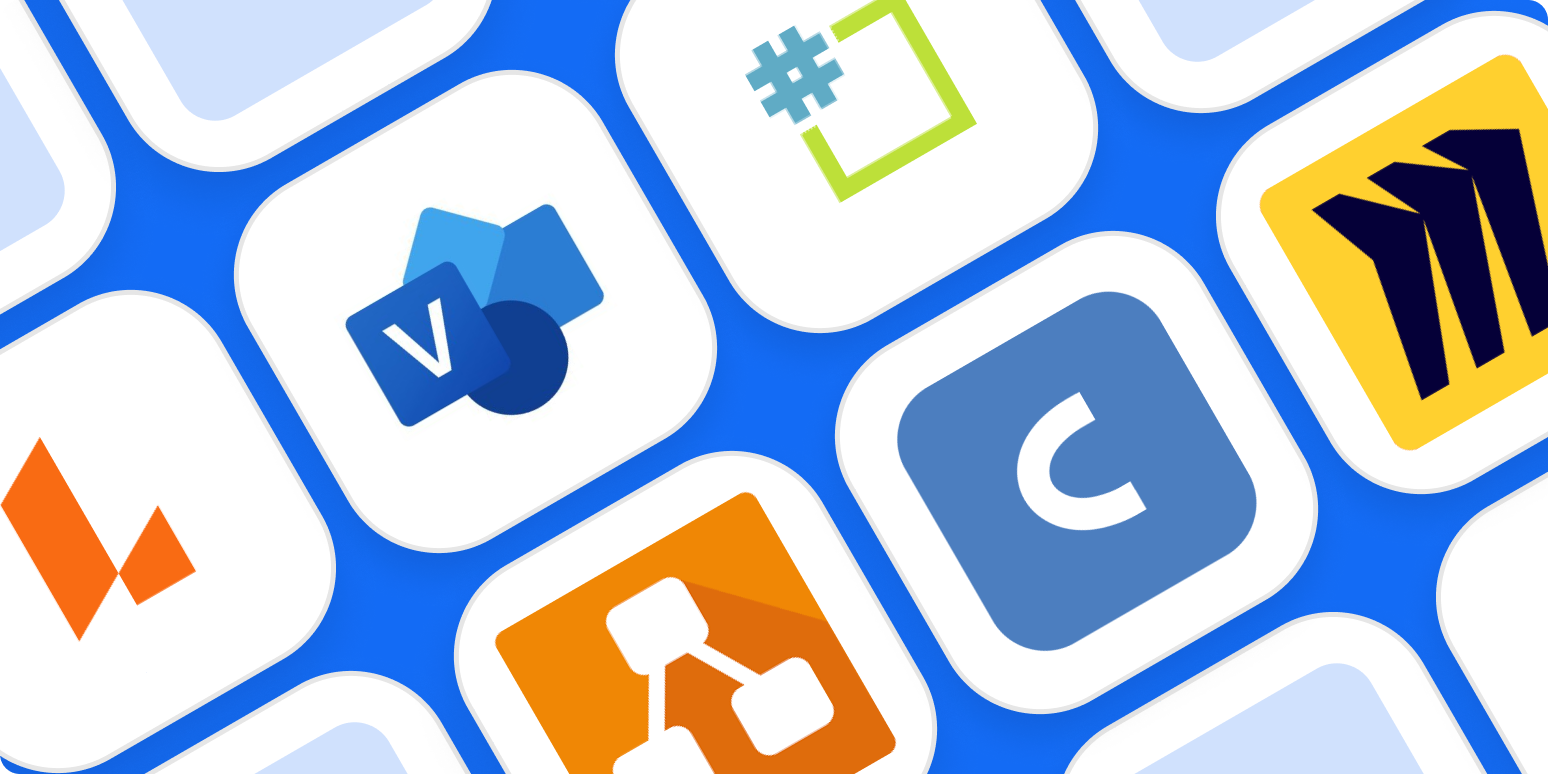Flowcharts and diagrams make complex information crystal clear. But the actual process of creating a flowchart or diagram is far from simple. I’ve been tasked with making a whole host of them throughout my career, and I can say for sure: the app you choose makes a difference.
5 things you should automate today
For this roundup, I spent several weeks researching and doing in-depth testing of the best flowchart and diagram software on the market. I narrowed it down to eight apps that represent the best options on the market, for a variety of use cases.
The 8 best flowchart and diagramming tools
-
Lucidchart for a Microsoft Visio alternative (and compatibility)
-
Microsoft Visio for Office power users
-
Textografo for a text-based flowchart tool
-
diagrams.net for a free flowchart maker for individual use
-
SmartDraw for the biggest collection of diagramming templates
-
Cacoo for making custom charts and graphs
-
Miro for a built-in whiteboard and team collaboration features
-
Zen Flowchart for simple flowcharts
What makes great flowchart and diagramming software?
How we evaluate and test apps
All of our best apps roundups are written by humans who’ve spent much of their careers using, testing, and writing about software. We spend dozens of hours researching and testing apps, using each app as it’s intended to be used and evaluating it against the criteria we set for the category. We’re never paid for placement in our articles from any app or for links to any site—we value the trust readers put in us to offer authentic evaluations of the categories and apps we review. For more details on our process, read the full rundown of how we select apps to feature on the Zapier blog.
I remember once I had to use Whimsical to create a massive flowchart, one that detailed the process of revamping a website for a client. It had to include the work that needed to be done for each page (website copy, design, SEO, etc.) and include steps for each team member and the approval process. I was in over my head.
I spent a full week working on the assignment, spending hours each day tinkering with text boxes, aligning shapes and connectors, designing my chart so it looked presentable to my team. It was painful—mostly because I was working with the wrong software as a beginner.
That’s all to say, there’s no one best way to create a flowchart: you need to be sure the app you choose suits your specific needs. As I was testing, I kept this in mind, looking for tools that served a variety of use cases; but I also made sure to test all the flowchart tools and diagramming software against the same criteria as a baseline:
-
Ease of use. I looked at the difficulty level for beginners, the number of features and tools you need to learn to use the app, and how intuitive the user interface was.
-
The ability to create clear and logical diagrams. I made sure there was a variety of standard shapes available to work with. I also looked for features that helped arrange things in a clear and logical way, like grids, auto-snapping shapes, and ratio aspect size adjusters.
-
Templates. Building from scratch isn’t necessary if your tool has an adequate selection of flowchart/diagram templates. I looked for look for industry-, role-, and task-specific templates, and considered their design, aesthetic, and customizability.
-
Team collaboration. Sharing, editing, video chat, and real-time collaboration features are huge assets. Also, it’s important to have the ability to import and export diagrams from and to a range of formats for better sharing and integration.
-
Value for price. For all the apps featured here, the price is justifiable for the features offered and the target customer base.
After researching and testing 30 flowchart and diagram tools over the course of several weeks, these are the eight best.
Best Microsoft Visio alternative
Lucidchart (Web)

Lucidchart is among the best-known online flowchart and diagramming tools on the web right now, and it’s not hard to see why.
Sign up for a free trial, and you’ll be creating your first flowchart or diagram right away. The web-based interface offers hyper-specific templates for API workflows, accounts receivable, algorithms, software mockups, and more. There’s also a wide range of standard shapes available, and you can create, save, and name your own for a more customized design. But what really makes Lucidchart the best Visio alternative is its user interface: it sports a familiar Windows File/Edit/View menu bar, full of relevant features that are easy to navigate. It’s simple to add and arrange items, and the process for making a flowchart is straightforward.
The flexible web app has a wider range of import options than any other software I tested; it receives files from most competitors, including Microsoft Visio, OmniGraffle, Gliffy, and diagrams.net. Lucidchart can also export to PDF, image files, SVGs, and Microsoft Visio (unlike most other web-based applications). Its design and color palettes are sleek, beautiful, and modern, outshining Visio’s outdated and duller-looking templates. And it boasts ample flexibility, meaning it can fit nicely into your existing workflow, or even serve as a complete Visio replacement.
Lucidchart also offers real-time online collaboration. This means that, similar to Google Docs, you can see edits and comments from your coworkers in real-time.
The only real competitor to Lucidchart is MyDraw—another Microsoft Visio-compatible app and alternative. Lucidchart’s interface, features, and tools are a lot more seamless and beginner-friendly, while MyDraw is built for advanced diagramming with a busier interface and templates made for bigger cross-team collaboration projects.
Lucidchart’s free trial allows you to create and save up to three (limited) documents. Unlike other free trials, this one doesn’t expire, so it may be enough for occasional diagramming. For this reason alone, Lucidchart is worth checking out for Office 365 users.
You can do even more by using Lucidchart’s Zapier integrations, which will allow you to connect Lucidchart to all your other apps. Automatically add new form responses, tasks, and more to your Lucidchart data sets. Here are a couple examples:
Lucidchart price: Free version available; paid version starts at $7.95.
Best diagram software for Microsoft Office 365 users
Microsoft Visio (Windows, Web)
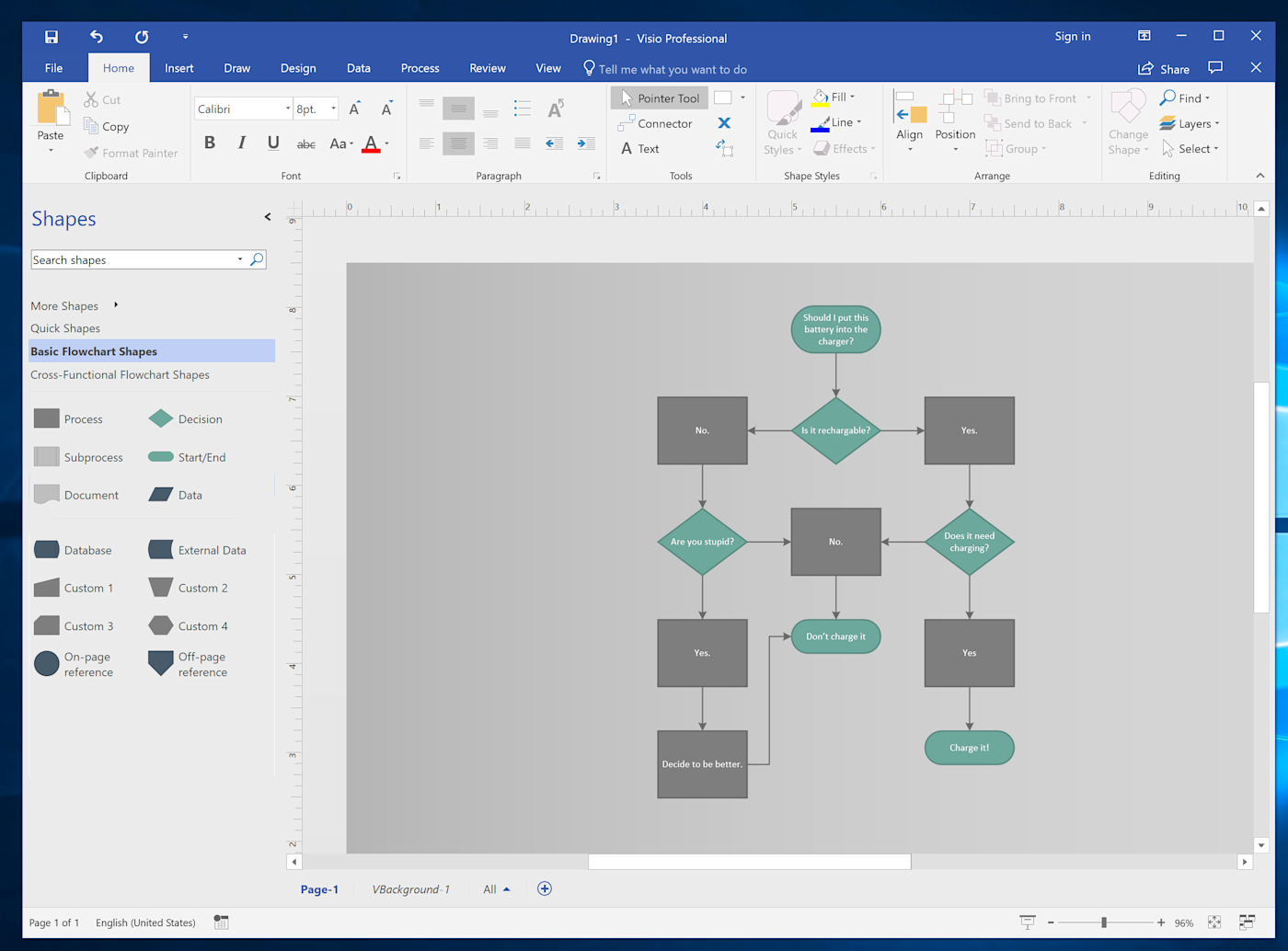
Microsoft has been working on Visio for a quarter-century, and it shows: the Windows version of this application is polished. The familiar Microsoft Office interface makes it easy to navigate all the various functions, meaning you’ll be creating something in no time.
Whether you’re making a flowchart, floorplan, software mockup, or engineering diagram, Visio offers appropriate shapes and templates. But it’s definitely not design-focused: I was kind of surprised by how outdated and lifeless the templates looked in comparison to Lucidchart or MyDraw (two Visio-compatible alternatives). Of course, Windows has always been the go-to operating system for serious professionals, but even serious professionals need to have fun and get creative! The image database is also limited, with generic graphics, so you’ll probably end up having to import better images.
The real standout feature for me was automatic sorting for flowcharts. I made a complicated sequence flowchart and had difficulty positioning shapes and frames neatly. Then I clicked the automatic sorting feature, and it cleaned up my mess perfectly like a robotic vacuum. Very few programs that I tried offer this level of polish.
The main downside here—and it’s notable—is the price. There are two services: a monthly subscription (cheaper option), and a one-time purchase (expensive option) that you’ll own forever. Only the one-time purchase offers access to the Windows Visio app; the cheaper option provides access to the web-based version only.
Is Visio worth it? I’d say the subscription is, especially if you create complicated diagrams and flowcharts regularly. But making a one-time purchase may not be the wisest decision: if you’re not satisfied with the current version, you won’t receive shiny new features in the future. And you have to buy a license for each PC, which can get costly.
Microsoft Visio price: A one-time purchase of Visio for Windows is $309 for Standard or $579 for Professional; Professional offers additional shapes and data visualization features. $15/user/month for a subscription to the Windows version (on top of any other Office plan); $5/user/month for Visio Online.
Best text-based flowchart software
Textografo (Web)
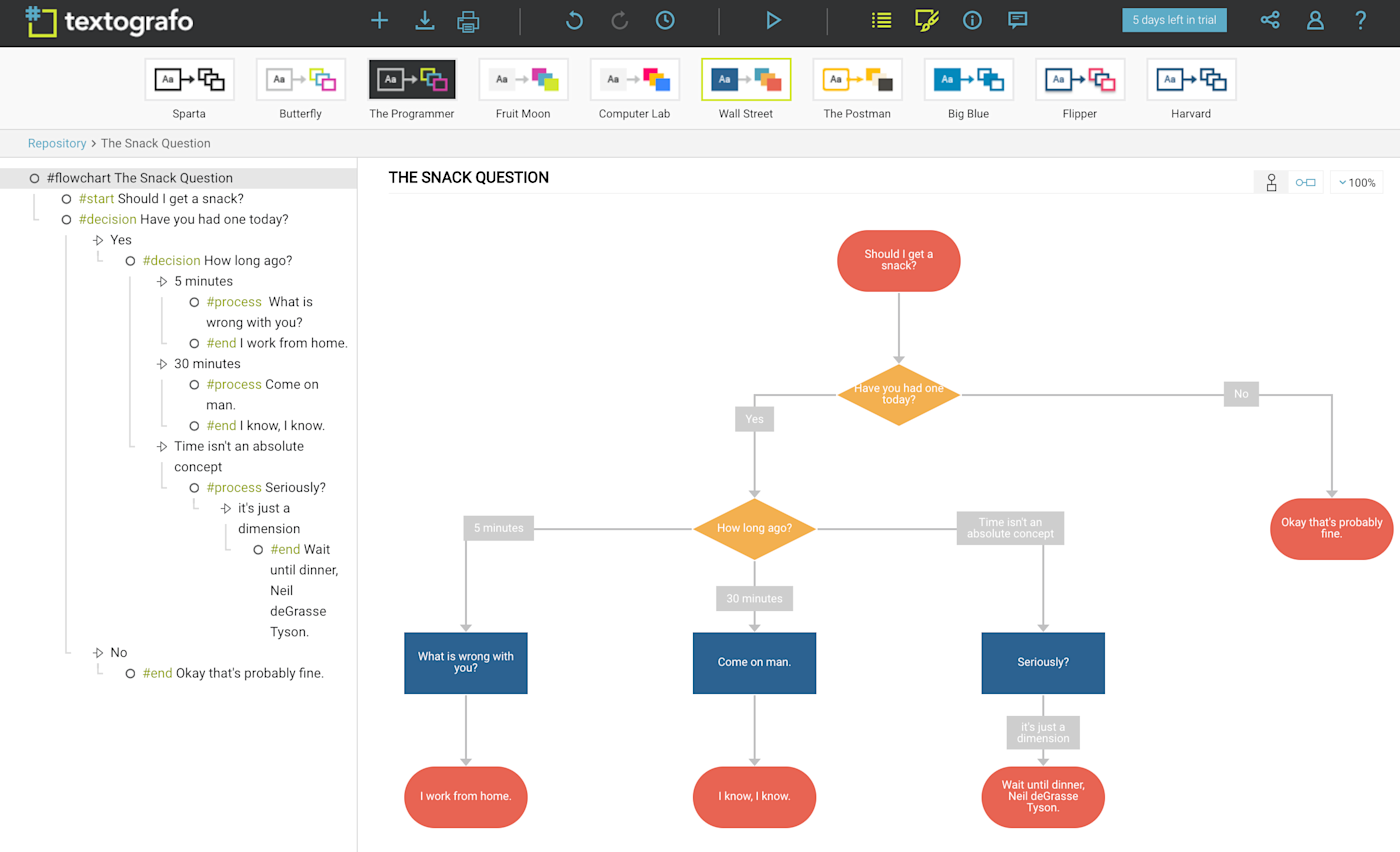
Most flowchart tools force you to move a lot of boxes around. Not Textografo. This unique tool is entirely text-based, making it an alternative to the drag-and-drop model. You can make a flowchart by typing in each flow, without moving your fingers away from the keyboard. You’ll need to learn some basic syntax: hashtags specify shapes, indents specify nesting. Type in the left panel, and your flowchart will show up in the right main workspace as if you were using a Markdown editor.
I’ll have to be honest—I didn’t love this software as a beginner. My preference is the drag-and-drop model, so learning the textual syntax and typing a sentence for each flow (as well as rewriting it when I needed to make changes) felt like more work.
While Textografo didn’t work for me, I can clearly see the benefit for more technical teams, especially programmers (who are used to writing code). Teams that want to create complex charts, but have no desire for design-focused templates or creative features, might find this to be the fastest tool—once they’ve mastered the textual syntax, that is.
Keep in mind, there are no templates to help you build a flowchart, and you can’t drag your items to move them: try it, and you’ll be told “Nope!” Everything has to be done in the text editor. This means Textografo can’t work as a general diagramming tool: it’s limited to flowcharts, decision trees, sitemaps, and other things that boil down to text boxes connected by arrows. But if you want a quick way to make flowcharts, without any fussing around with your mouse and design features, Textografo is for you.
Textografo price: Plans start at $4/month.
Best free diagram software for individuals
Diagrams.net (Web, Windows, Mac, Linux, ChromeOS)
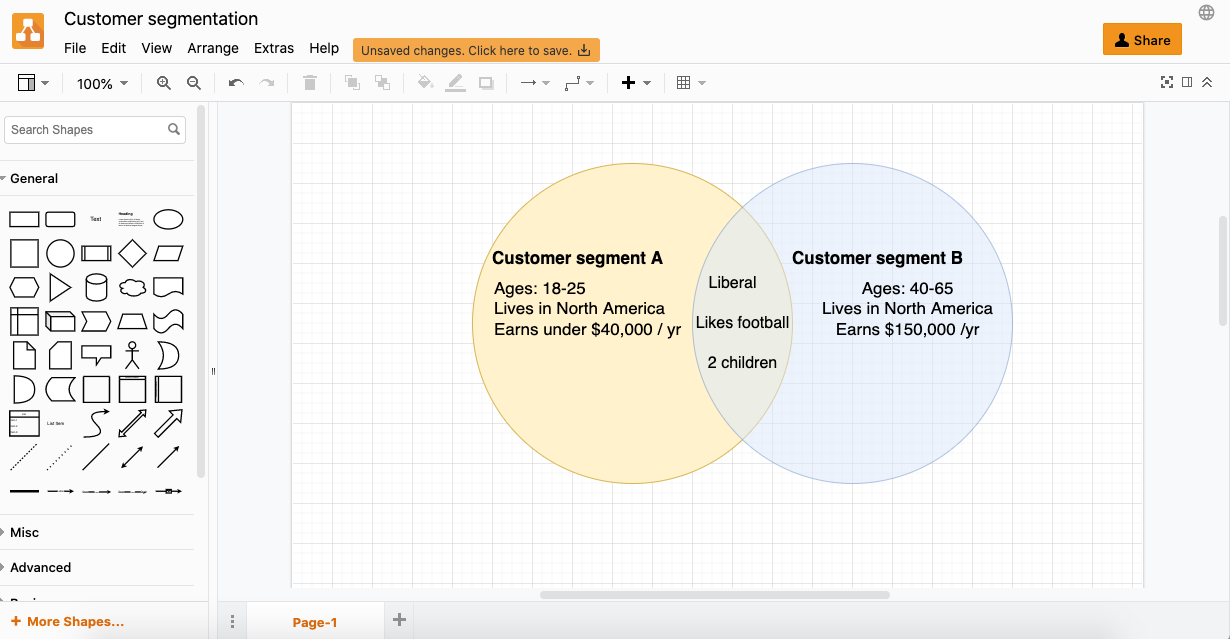
Diagrams.net (formerly draw.io) sets itself apart by price: it’s free for personal use, and you don’t even need to create an account to get started. But that’s not the only reason it’s worth checking out.
The user interface, which closely resembles that of Google’s apps, is easy to learn. It lets you find what you need quickly without looking around. The shapes are organized and placed in separate flowchart and diagram categories and are nicely labeled (e.g., process, document, finish), so I didn’t have to look up how each shape was used to make my diagram. Arranging objects is simple thanks to a clearly defined grid, although the automatic arrangement options aren’t as robust as I would have liked (but again—free). There’s also the optional dark theme, which some people might appreciate.
Files can be stored locally on your computer or using cloud services like OneDrive and Google Drive. You can also import files from Visio, Gliffy, and Lucidchart, or export to just about every format you can imagine, including vector files.
One unique feature, at least among online flowchart apps: diagrams.net offers an offline version for Windows, macOS, Linux, and even Chromebooks. This means you can edit your design without an internet connection, assuming you’ve saved them to your device instead of the cloud.
As for downsides, the number of shapes and templates offered is small: there are only nine flowcharts and eight Venn diagram templates. Also, there’s a lack of real-time collaborative editing, and workspace sharing is limited to Google Drive and OneDrive files. Overall, this is a very flexible piece of software that doesn’t take a lot of time to learn. It’s well worth it for individual use, especially if you only need the occasional design.
Diagrams.net price: Free
Best collection of diagramming templates in a web-based diagram app
SmartDraw (Web)
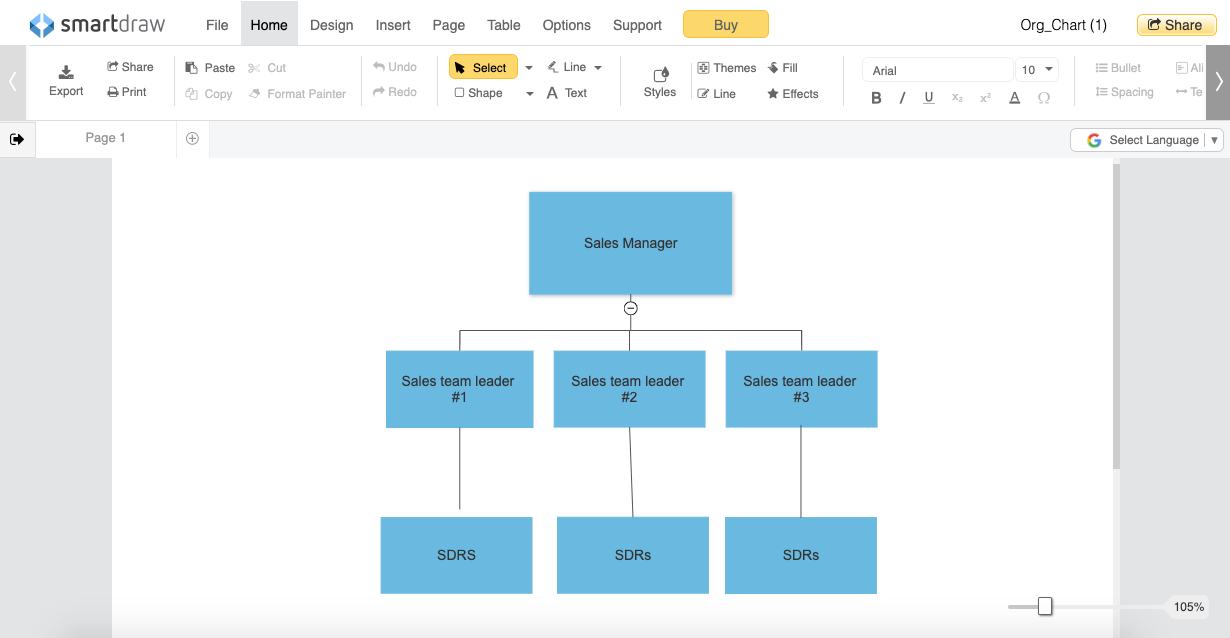
SmartDraw is versatile. It has one of the most comprehensive template libraries for advanced diagrams—from software design to wireframes to graph-based, spanning several industries, including retail, marketing, IT, eCommerce, and legal. There’s even a surprisingly large collection of maps you can use, from Canadian provinces to European countries. It’s one of the most complete collections of templates I found.
It was moderately easy to use, but I did have some difficulty positioning connectors and resizing my flowchart since the app doesn’t automatically align them.
Files can be saved to SmartDraw or third-party solutions, including Google Drive, Dropbox, OneDrive, and Box. Designs can also be exported to Visio, image forms, or an SVG vector, meaning you can use these charts just about anywhere.
The downside here is the user interface: it’s just a little bit clunky when compared to Lucidchart or Visio. I also thought the pre-set color palettes were kind of basic and uninspiring. You’ll figure out how to do everything eventually, sure, but I wish it was just a little more polished and sleek. Should you give it a go? Yes, especially if you use a ton of Venn diagrams and have clients in several industries.
There’s a seven-day free trial, so try it out for yourself before deciding to subscribe.
SmartDraw price: $9.95/month after a free trial.
Best diagram app for quickly making diagrams that include custom charts
Cacoo (Web)

Cacoo is a flowchart and diagram tool that doubles as a digital whiteboard where teams can brainstorm, take notes, and create images, just like with a real whiteboard.
Because of this app’s simple user interface and great design, I had zero difficulties making a flowchart from scratch. The standard flowchart shapes aren’t offered by default, but there are templates you can use as a starting point. I appreciated Cacoo’s variety of industry-specific templates for marketing, sales, accounting, and advertising, as well as options for mind maps, Venn diagrams, and calendars.
There’s also a chart function, which lets you quickly enter or paste data to make a simple bar, pie, and trend charts. You can then integrate these charts into the rest of your diagram. You could easily create such charts using Excel and then add them to your diagram, sure, but it’s nice for everything to have the same visual style.
Cacoo has one of the best team collaboration features on our list. It has a shared workspace that allows you to video chat with up to five people at a time, all while using the whiteboard feature to brainstorm. I tested the video quality, and it was crystal clear with no lag.
Cacoo exports to images, vectors, and even PowerPoint files. There’s also support for importing from Visio. And if you use Cacoo’s Zapier integrations, you can do things like automatically generate Cacoo diagrams based on new tasks in your project management tool.
Cacoo price: $15/month after a 14-day free trial.
Best diagram software for whiteboarding and team collaboration
Miro (Web, Windows, iOS, macOS)
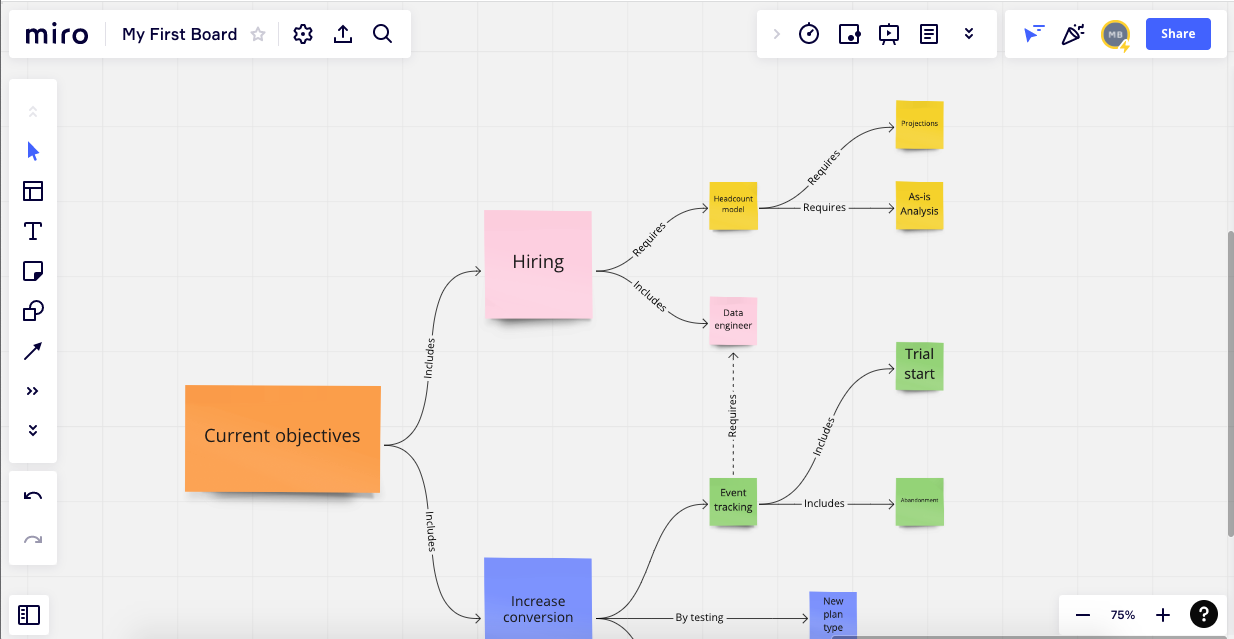
Miro has a comprehensive set of features and tools to let you create a stunning design with your flowcharts and diagrams. When you enter the web app, you’re immediately presented with templates for flowcharts, customer touchpoints, user stories, UML communication diagrams, and more—all of which are beautifully designed. I felt absolutely spoiled with the number of options I had to choose from.
Tools are arranged in a logical order, with no more than nine displayed on the left-hand side, so it never felt overwhelming. And the tools you aren’t using are automatically hidden, so the whiteboard feels spacious and comfortable without you having to adjust the size of the flowchart or diagram.
Miro truly feels like an actual whiteboard, just with better handwriting than you. And there are digital sticky notes and screen sharing features, so you don’t need a third-party app like Zoom. The team collaboration features are second-to-none; Cacoo is great, but Miro is also available on non-web platforms.
Miro also integrates with Zapier, so you can do things like automatically create a card on a board in Miro when there’s a new Slack message in a channel or automatically create Miro widgets based on a new Trello card.
Miro price: Starts at $8/member/month, billed annually.
Best diagram app for making simple flowcharts
Zen Flowchart (Web)

Are you looking for a simple flowchart tool without the theatrics? Zen Flowchart is your answer. They brand themselves as “the simplest flowchart maker,” and it couldn’t be more true.
Just click on the All Shapes tab, and a library of basic shapes and connectors will be displayed. There’s also a healthy selection of buttons for dates, charts, and labels. On top of that, it’s one of the only “one-click” apps for creating flowcharts: you click a node, and a new box will appear—no need to move shapes or connectors around.
As for templates, there are only nine available for the free version, which is a little disappointing—you’ll have to sign up for their paid option to get a comprehensive library of options. But if you’re looking for something basic, this library will suffice. And compared to other basic free web apps like diagrams.net, the design here is sleek and contemporary.
Zen Flowchart price: Starts at $5.90/month, billed annually.
This article was originally published in December 2018 by Justin Pot.
[adsanity_group align=’alignnone’ num_ads=1 num_columns=1 group_ids=’15192′]
Need Any Technology Assistance? Call Pursho @ 0731-6725516

